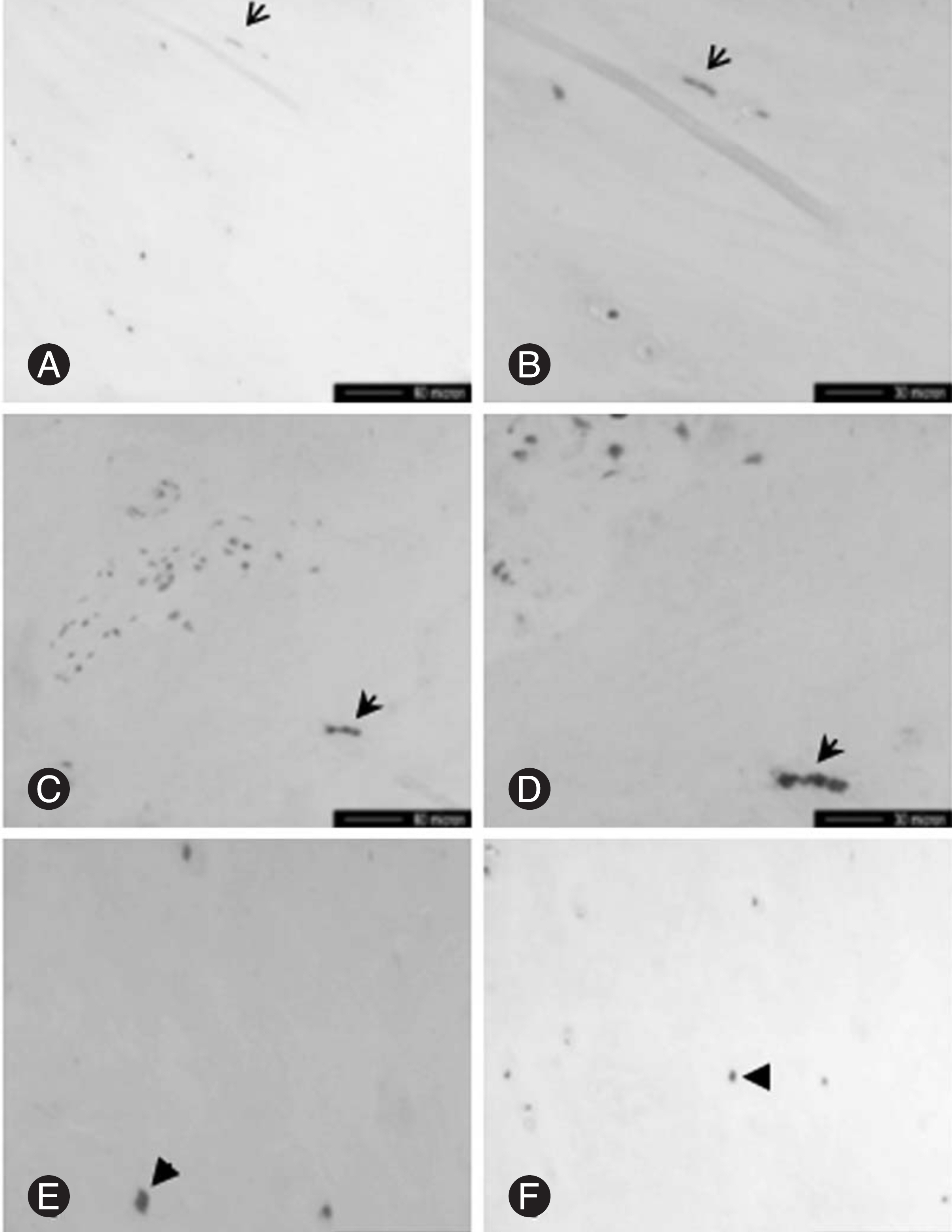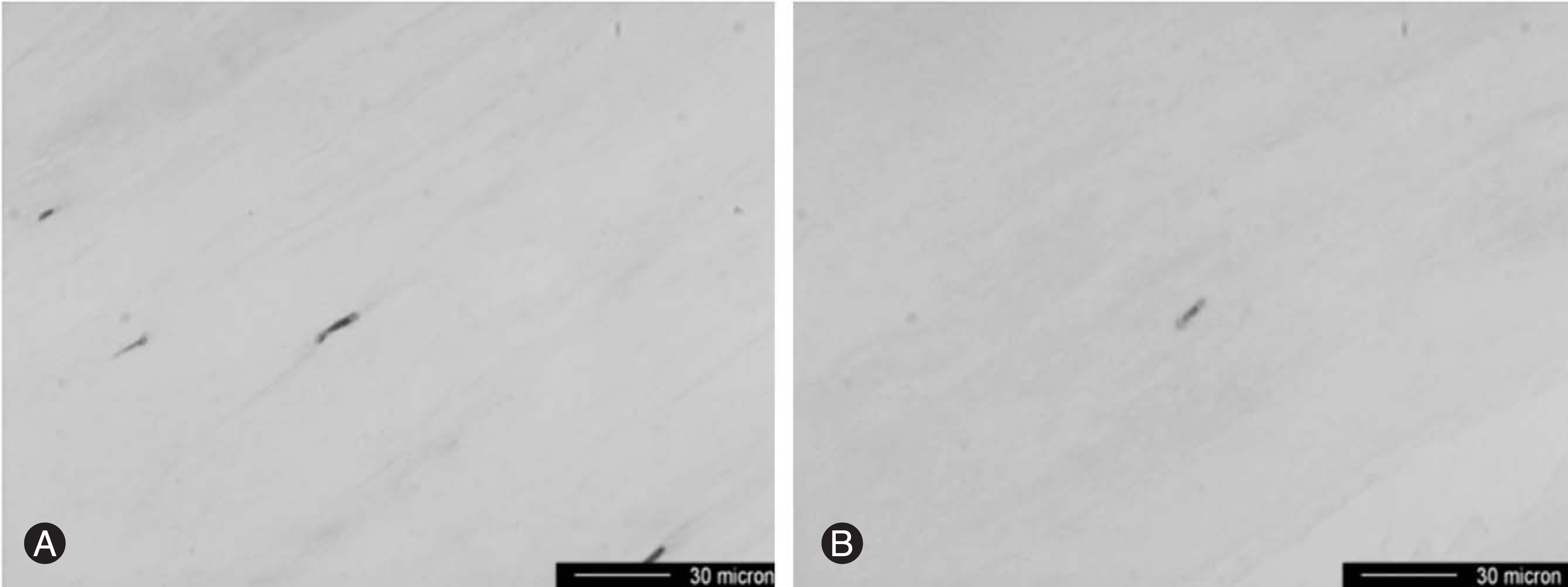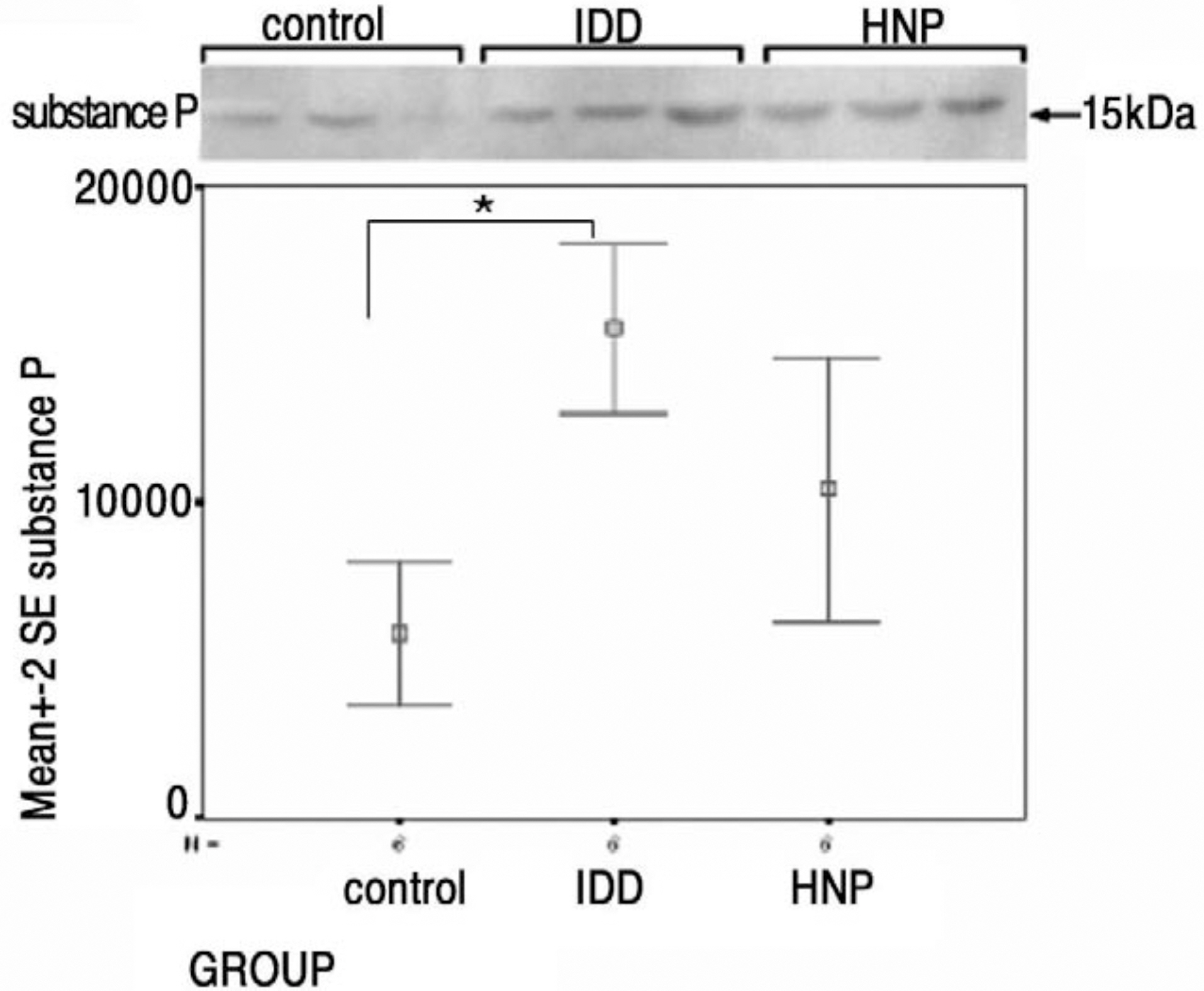J Korean Soc Spine Surg.
2006 Dec;13(4):275-283.
Nerve Ingrowth into Intervertebral Disc in Internal Disc Disruption
- Affiliations
-
- 1Department of Orthopedic Surgery, Kang-Nam St. Mary's Hospital, College of Medicine, The Catholic University of Korea, Seoul, Korea. kyh@catholic.ac.kr
Abstract
-
STUDY DESIGN: The ingrowth of the nociceptive nerve ending into intervertebral disc was examined using immunohistochemistry and quantified using western blotting.
OBJECTIVES
To determine if the nociceptive nerve innervates into the intervertebral discs of internal disc disruption (IDD). SUMMARY AND LITERATURE REVIEW: Nociceptive nerve ending and vessel ingrowth into intervertebral disc is associated with IDD and HNP. Substance P is a neurotransmitter that is found in the nociceptive nerve endings. Immunohistochemistry has confirmed the presence, and western blot has isolated the target. The localization of novel nociceptive innervation, and a quantitative comparison was made according to the original pathology is of interest.
MATERIALS AND METHODS
10 specimens of intervertebral disc were collected from IDD during total disc replacement surgery , and another 10 specimens of intervertebral disc from HNP were collected during discectomy. The control samples of intervertebral disc were obtained from 3 adolescent patients with idiopathic scoliosis, and 2 patients with a lumbar bursting fracture. Standard immunohistochemical techniques were used to test for the nociceptive neurotransmitter (substance P), which is a protein expressed during axonogenesis (growth-associated protein 43, GAP43), and a general nerve marker (protein gene produce 9.5, PGP9.5). The expression of substance P protein was quantified using western blot for its polyclonal antibody.
RESULTS
In IDD (n=10), substance P was expressed in 6 cases of outer annulus fibrosus (AF), 5 cases of inner AF, and 3 cases of nucleus pulposus (NP). In HNP (n=10), substance P was expressed in 4 cases of outer AF, 3 cases of inner AF, and 2 cases of NP. In the control group, only 2 cases expressed substance P in outer AF. GAP43 was only positive in outer AF as follows: IDD 3 cases, HNP 1 case, and control 1 case. None of the specimens showed localized PGP 9.5. Substance P was localized significantly in larger quantities in IDD than in the control group (p=0.002). In HNP, the expression level was larger than the control and lower than the IDD group but this was not statistically significant (p=0.158, p=0.108).
CONCLUSIONS
Innervation of nociceptive nerve endings was identified at the degenerative intervertebral disc of IDD, which may contribute to back pain.
Keyword
MeSH Terms
Figure
Reference
-
1). Hirsch C, Ingelmark BE, Miller M. The anatomical basis for low back pain. Studies on the presence of sensory nerve endings in ligamentous, capsular and intervertebral disc structures in the human lumbar spine. Acta Orthop Scand. 1963; 33:1–17.
Article2). Bogduk N, Windsor M, Inglis A. The innervation of the cervical intervertebral discs. Spine. 1988; 13:2–8.
Article3). Weinstein J, Claverie W, Gibson S. The pain of discography. Spine. 1988; 13:1344–1348.
Article4). Weinstein J, Pope M, Schmidt R, Seroussi R. Neu-ropharmacologic effects of vibration on the dorsal root ganglion. An animal model. Spine. 1988; 13:521–525.5). Stolker RJ, Vervest AC, Groen GJ. The management of chronic spinal pain by blockades: a review. Pain. 1994; 58:1–20.
Article6). Bleys RL, Groen GJ, Matthijssen MA. A method for identifying peripheral connections of perivascular nerves based on sensitive acetylcholinesterase staining via perfusion. J Histochem Cytochem. 1994; 42:223–230.
Article7). Groen GJ, Baljet B, Drukker J. Nerves and nerve plexuses of the human vertebral column. J Anat. 1990; 188:282–296.
Article8). Morinaga T, Takahashi K, Yamagata M, et al. Sensory innervation to the anterior portion of lumbar intervertebral disc. Spine. 1996 Aug 15; 21:1848–1851.
Article9). Ashton IK, Ashton BA, Gibson SJ, Polak JM, Jaffray DC, Eisenstein SM. Morphological basis for back pain: the demonstration of nerve fibers and neuropeptides in the lumbar facet joint capsule but not in ligamentum flavum. J Orthop Res. 1992; 10:72–78.
Article10). Pedersen HE, Blunck CF, Gardner E. The anatomy of lumbosacral posterior rami and meningeal branches of spinal nerve (sinu-vertebral nerves); with an experimental study of their functions. J Bone Joint Surg. 1956; 38-A:377–391.11). Malinsky J. The ontogenetic development of nerve termi-nations in the intervertebral discs of man. (Histology of intervertebral discs, 11th communication). Acta Anat (Basel). 1959; 38:96–113.12). Jackson HC, Winkelmann RK, Bickel WH. Nerve endings in the human lumbar spinal column and related structures. J Bone Joint Surg. 1966; 48-A:1272–1281.
Article13). Yoshizawa H, O'Brien JP, Smith WT, Trumper M. The neuropathology of intervertebral discs removed for low-back pain. J Pathol. 1980; 132:95–104.
Article14). Kaapa E, Gronblad M, Holm S, Liesi P, Murtomaki S, Vanharanta H. Neural elements in the normal and exper-imentally injured porcine intervertebral disk. Eur Spine J. 1994; 3:137–142.
Article15). Osti OL, Vernon-Roberts B, Fraser RD. 1990 Volvo Award in experimental studies. Anulus tears and intervertebral disc degeneration. An experimental study using an animal model. Spine. 1990; 15:762–767.16). Saifuddin A, Braithwaite I, White J, Taylor BA, Ren-ton P. The value of lumbar spine magnetic resonance imaging in the demonstration of anular tears. Spine. 1998; 23:453–457.
Article17). Vernon-Roberts B, Fazzalari NL, Manthey BA. Pathogenesis of tears of the anulus investigated by multiple-level transaxial analysis of the T12-L1 disc. Spine. 1997; 22:2641–2646.
Article18). Burke JG, Watson RW, McCormack D, Dowling FE, Walsh MG, Fitzpatrick JM. Intervertebral discs which cause low back pain secrete high levels of proinflammato-ry mediators. J Bone Joint Surg Br. 2002; 84:196–201.
Article19). Henry JL. Relation of substance P to pain transmission: neurophysiological evidence. Ciba Found Symp. 1982; 91:206–224.
Article20). Giles LG, Harvey AR. Immunohistochemical demonstration of nociceptors in the capsule and synovial folds of human zygapophyseal joints. Br J Rheumatol. 1987; 26:362–364.
Article21). Korkala O, Gronblad M, Liesi P, Karaharju E. Immunohistochemical demonstration of nociceptors in the ligamentous structures of the lumbar spine. Spine. 1985; 10:156–157.
Article22). McCarthy PW, Petts P, Hamilton A. RT97- and calci-tonin gene-related peptide-like immunoreactivity in lumbar intervertebral discs and adjacent tissue from the rat. J Anat. 1992; 180:15–24.23). Ashton IK, Roberts S, Jaffray DC, Polak JM, Eisenstein SM. Neuropeptides in the human intervertebral disc. J Orthop Res. 1994; 12:186–192.
Article24). Coppes MH, Marani E, Thomeer RT, Groen GJ. Innervation of "painful" lumbar discs. Spine. 1997; 22:2342–2350.
Article25). Freemont AJ, Peacock TE, Goupille P, Hoyland JA, O'Brien J, Jayson MI. Nerve ingrowth into diseased intervertebral disc in chronic back pain. Lancet. 1997; 350:178–181.
Article26). Peng B, Wu W, Hou S, Li P, Zhang C, Yang Y. The pathogenesis of discogenic low back pain. J Bone Joint Surg Br. 2005 Jan; 87:62–67.
Article
- Full Text Links
- Actions
-
Cited
- CITED
-
- Close
- Share
- Similar articles
-
- Neural Mechanisms of Discogenic Back Pain: How Does Nerve Growth Factor Play a Key Role?
- Biochemical Factors of Intervertebral Disc Degeneration: Implications for Disc Regeneration
- A Case of Nerve-Root Anomaly Associated with Herniated Intervertebral Disc in Lumbar: Case Report
- Spinal Nerve Root Swelling Mimicking Intervertebral Disc Herniation in Magnetic Resonance Imaging: A Case Report
- Spontaneous Total Resolution of Severe Lumbar Disc Herniation





